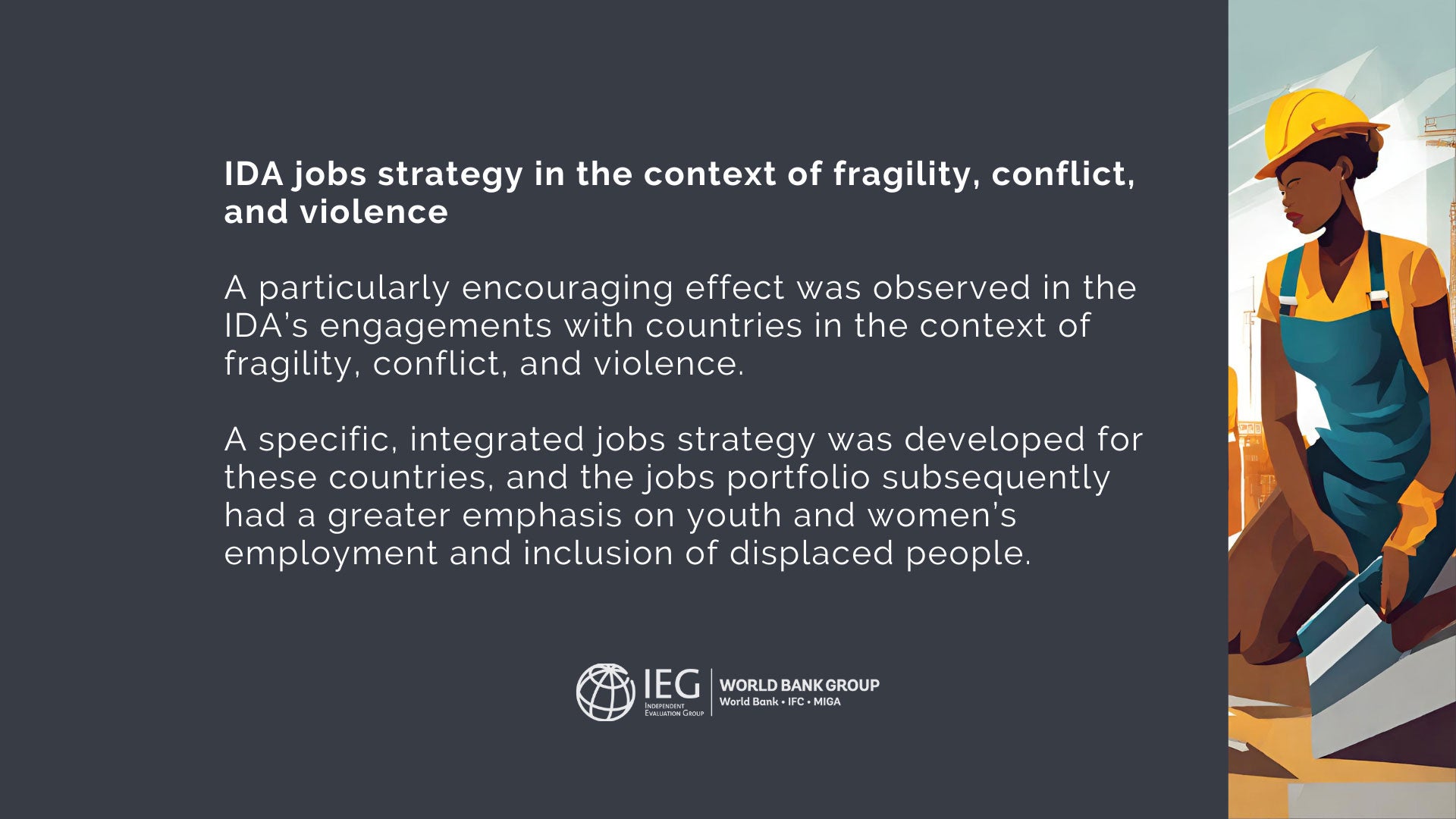Creating more, better, and more inclusive jobs is essential to the efforts of any country or development organization seeking to reduce poverty and increase shared prosperity. That’s why, since the middle of the last decade, the International Development Association (IDA), the World Bank’s fund for the world’s poorest countries, has made jobs a particular focus for the financing and support it offers.
In this blog, we explore the findings of a recent report by the Independent Evaluation Group (IEG) that evaluates how effective this work has been in meeting IDA’s and the World Bank’s ambitious employment objectives.
A strategy for better employment
IDA has recognized the importance of jobs in tackling poverty and inequality by making jobs a core part of three rounds of financing for countries between 2015 and 2022.
To this end, it implemented what the IEG’s report agreed was a clear jobs strategy—one that was more nuanced than simply “create more jobs.”
Instead, it targeted the creation of better-paid jobs and more inclusive jobs that employ women, young people, and people belonging to marginalized groups. Its overarching objective was to provide more, better, and more inclusive jobs to improve productivity, incomes, and working conditions.
Over the evaluation period, IDA and the World Bank sought to meet this objective by implementing a mixture of policies, operations, financing, and other interventions.

The spread of regions in which IDA implemented its jobs strategy broadly matches the overall distribution of its resources across countries ranging from Ghana to Haiti and Rwanda to the Kyrgyz Republic. Most jobs projects took place in the Eastern and Southern Africa Region.
On track: Positive impacts of the IDA jobs strategy
The report found that the clear and coherent IDA jobs strategy in the period 2015–2022 noticeably influenced its approaches in individual countries. Most of the jobs diagnostics in this period were tailored to country contexts and helped close significant knowledge gaps that existed. Previously, little attention had been paid to the factors influencing labor market outcomes in countries. But the IDA’s diagnostics on jobs brought with them actionable recommendations, and it was observed that the evidence from these diagnostics often strengthened subsequent IDA and World Bank policy commitments and interventions.
For example, evidence that showed the need to complement the increase in agricultural productivity with promoting agribusiness to create new jobs led to policy commitments that reflected learning from this evidence. Agribusiness is a fast-growing industry in many countries with strong potential for job creation in the future.
The relative size of the portfolio also increased slightly with an increase in projects supporting the demand for labor from firms over the evaluation period. The mix of jobs interventions also changed with a shift toward support for agribusiness and agricultural value chains and an increase in the proportion of jobs-relevant projects that focused on improved labor market participation by women and youth.

Areas for improvement in jobs interventions
There is yet room for growth in the size of the jobs portfolio. There has clearly been an enhanced focus on jobs in IDA’s overall strategy. But the report finds that there has not been a significant increase in the size of the jobs portfolio. Simply put, the total number of jobs in the areas evaluated has only increased slightly over the 2015–2022 period.
This could appear to give cause for concern given that the financial commitment to jobs-related projects increased from $6.5 billion to $9.7 billion over this period. This financing has, however, led to an important change in the mix of jobs interventions.
The jobs strategy’s promise of improving the way results are measured also needs more work. Although impact evaluations have become more frequent, results frameworks continue to track outputs rather than outcomes, and many countries’ labor market statistics are still lacking.
This lack of data and analysis means that little is known about the effectiveness of many jobs interventions. There are existing weaknesses in results measurement or in country-level statistical systems that measure labor market developments.
Jobs interventions require collaboration across different teams from different sectors and technical families. There continue to be some barriers to this collaboration. For example, there are practical questions about which teams control budgetary resources and there are differences in perspective across sectors about the best approach to take for the jobs objective. In addition to these barriers, the jobs agenda is not managed in a centralized manner within most client governments, which can contribute to fragmented policy dialogues across different government interlocutors.
Recommendations to improve the World Bank’s jobs agenda
The report offers two main recommendations to address these challenges and improve the impact of IDA’s jobs strategy more broadly in future interventions.
First, it recommends that IDA strengthen the way it measures its contributions to the achievement of the jobs objectives.
This requires better and more relevant indicators at the level of companies, better project monitoring and evaluations, and more support for countries’ own statistical gathering and measurement of labor market outcomes. Doing this could significantly improve learning, adaptation, and accountability in future rounds of financing.
Second, IDA should go even further to draw on its findings in relation to the jobs diagnostics and use them to inform how it engages in individual countries. It could do this by strengthening ownership and use of jobs diagnostics and apply these to inform policy dialogue and the design of jobs interventions.
For example, Country Management Units could better incentivize cross-sector collaboration by drawing on diagnostics to establish an integrated and contextualized vision of policy priorities. This could be the basis of policy dialogue and project design.
There is exciting scope for improvement in the World Bank’s contribution to the jobs agenda, which could lead to many more high quality jobs.
This, in turn, could change millions of lives for the better.
Please stay tuned for future blogs based on the evaluation findings.











Add new comment